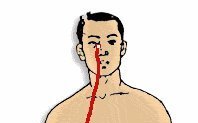What does the center represent? The east represents wood, the south represents fire, the west represents metal, the north represents water, and the center represents earth. The spine is at the very center of the human body, which is governed by earth, specifically the spleen. Achieving balance in the center leads to harmony, and harmony prevents illness. Moreover, earth nourishes the surrounding areas; in practice, the techniques involve not only the center and the spine but also the limbs. The limbs are also governed by the center, as the spleen governs the limbs. Regardless of where you apply your techniques, they are all based on the flesh, as the spleen governs flesh. This applies to the abdomen as well, as the large abdomen is also governed by the spleen and stomach. In essence, our operations and points of application are all centered, all earth, all spleen and stomach.
What does medicine involve? It is about achieving “central balance and harmony,” which means “guiding the body and mind back to central balance.” This is our understanding of medicine and disease. In fact, this can also extend to our understanding of Chinese culture. Once this issue is resolved, we can then look at Dao Yin and An Jiao with greater insight.
Why does Dao Yin and An Jiao start from the center? There is profound meaning in this. The center, or “zhong,” has a secular aspect that includes the east, west, south, and north. Beyond this, Chinese culture also has a transcendent aspect of “zhong,” which is non-oppositional.
When we talk about opposition, we naturally think of Yin and Yang. Yin and Yang are the most fundamental concepts in Traditional Chinese Medicine (TCM), as clearly stated in the “Huangdi Neijing”. The “Suwen: On the Correspondence of Yin and Yang” states: “Yin and Yang are the principles of heaven and earth, the framework of all things, the parents of change, the source of life and death, and the abode of the spirit. To treat disease, one must seek the root.” From a disciplinary perspective, it can be said that everything in TCM is built upon Yin and Yang.
What role does “zhong” (or balanced Qi) play? It has a harmonizing and resolving function, seeking unity in opposition and achieving harmony in contradiction. “Zhong” is the foundation of harmony and the guarantee of harmony! The balance of Yin and Yang, and the harmony of Yin and Yang, all rely on “zhong” to be realized.
In this sense, we call ourselves “Traditional Chinese Medicine”; the character “zhong” not only positions us in relation to Western medicine but also embodies the meaning of regulating Yin and Yang to achieve “central balance and harmony.” Only by standing on “zhong” can the function of “medicine” occur. “Zhong” is profound, and we need to better understand it.
The Ren and Du meridians are the two most important meridians in the human body because only these two meridians dare to occupy the center. To occupy the center means to take on responsibility. The Ren meridian, located at the front center, governs all Yin; the Du meridian, located at the back center, governs all Yang. In other words, if we want to regulate the Yin and Yang of the body, the key control and switch lie in the Ren and Du meridians. “Dao Yin and An Jiao start from the center” can also be said to mean that the focus of Dao Yin and An Jiao must first be placed on these two meridians.
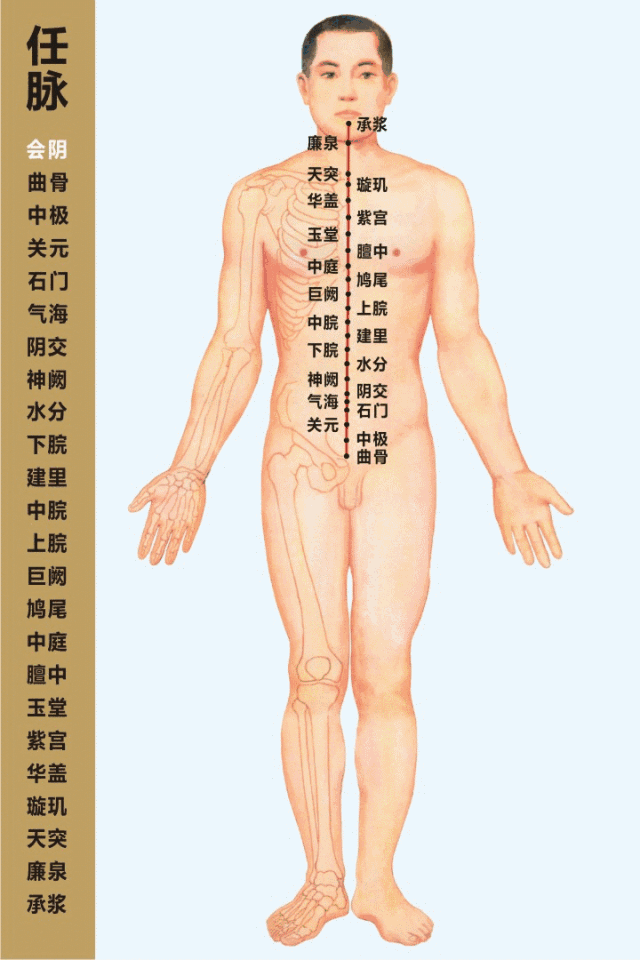

Additionally, we need to clarify what “An Jiao” means here. One interpretation is that “An” refers to hand techniques, while “Jiao” refers to foot techniques. In modern massage, there are indeed instances of using both hands and feet, although foot techniques are still relatively rare. I (Teacher Liu Lihong) do not believe that “Jiao” refers to foot techniques; it should refer to the “Qiao” meridians, specifically the Yin Qiao (Yin Heel) and Yang Qiao (Yang Heel) meridians, with the Yin Qiao being the closest to the center. I later found that Zhang Jingyue from the Ming Dynasty held the same view.
From a positional perspective, An Jiao should primarily focus on the center. Of course, what I (Teacher Liu Lihong) am discussing today is self-An Jiao, which is mainly limited to the front center, where the Yin Qiao meridian is located. Previously, my experience with abdominal pressing was a full abdomen press, pressing wherever it hurt. At that stage, it could not even be called An Jiao, let alone Dao Yin.
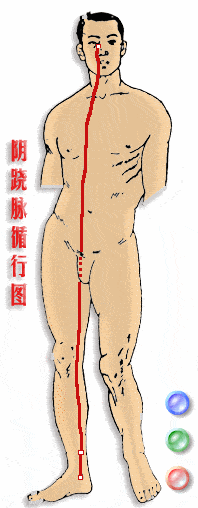
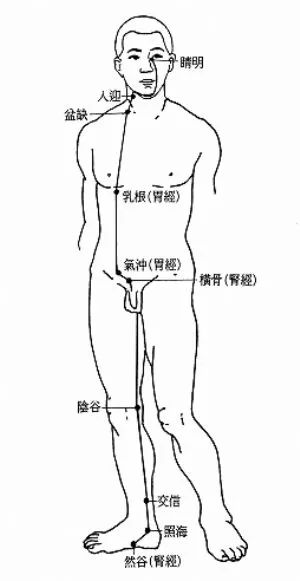
Looking back today, this remains a very important process; many friends have improved their health during this process. Abdominal pressing is actually a process of discovering and solving problems. Finding the painful points or hard knots means identifying the issues.
As stated in the “Suwen: On the Discussion of Deficiency and Excess,” there is a famous saying: “The imbalance of the five organs leads to the obstruction of the six bowels.” This clearly tells us that the imbalance of the five organs is caused by the obstruction of the six bowels. If the obstruction of the six bowels is resolved, the problems of the five organs will also be easily resolved.
Although these issues are generally limited to the area of the six bowels, the close connection between the six bowels and the five organs determines that these issues will inevitably affect the five organs. By pressing the abdomen, we can directly address the issues of the six bowels, which will ultimately lead to the resolution of the problems of the five organs.
Moreover, hospital treatments and health care can only play a small part in overall health. To seek true health, one must start from within and focus on oneself.
The above is an introduction to my understanding of TCM and Dao Yin An Jiao. Next, I will further elaborate on the methods of Dao Yin An Jiao. From personal experience, the most convenient time for practicing Dao Yin An Jiao is between 5-7 AM, which is also known as the “Mao” hour, when the Yangming Large Intestine Meridian is flowing.

At this time, pressing the abdomen primarily improves the Yangming Large Intestine. The Yangming Large Intestine governs the downward movement of the body, and the movement of Yin and Yang is essentially about rising and falling (entering and exiting), with rising and falling being mutually causal. When the downward movement is good, the upward movement will naturally be excellent. Many diseases in this era are related to poor downward movement, such as hypertension, hyperglycemia, hyperlipidemia, and high uric acid, all of which are related to poor downward movement. To regulate the downward movement, we must be able to rise during the flow of the Large Intestine, and the first adjustment must be to our daily routine. If you stay up late, you will be sound asleep at 5 AM.
What we discussed above mainly concerns An Jiao; what about “Dao Yin”? The issue of Dao Yin is profound, and the focus is still on Dao Yin rather than An Jiao. From the perspective of self-An Jiao, we can conveniently operate only on the chest and abdomen. From the perspective of meridians, there are only the Ren, Yin Qiao, Shaoyin, Jueyin, Yangming Stomach, and Taiyin Spleen meridians, etc. How do the Du meridian, Bladder meridian, and Yang Qiao work? This requires the application of Dao Yin, which has a comprehensive effect.
The principles of Dao Yin are the same as those of acupuncture. In the “Suwen: On the Correspondence of Yin and Yang,” there is an important statement: “Those who are skilled in acupuncture draw Yang from Yin and Yin from Yang, treating the right side for the left and the left side for the right.” This is the principle of acupuncture and also the principle of Dao Yin. However, nowadays, practitioners of acupuncture often disregard this. For example, if we have pain in the right knee joint, most doctors in the acupuncture department will focus on needling the right knee. While needling the right knee is not wrong, it does not reflect the skillful use of needles.
The traditional concept has already been clearly defined here, but we find it difficult to follow. We tend to believe that direct effects should be better, and establishing the “seen” is indeed very challenging. As mentioned earlier, the “Neijing” provides the guiding principle of “drawing Yang from Yin and Yin from Yang,” which is the general rule of Dao Yin. For instance, when we touch the Ren and Qiao meridians at the front, this is drawing from Yin, and the operation of “drawing from Yin” will inevitably bring about the effect of “drawing Yang.” Drawing Yang first activates the Du meridian, which in turn activates all Yang. Once Yang is in motion, it will naturally produce the effect of drawing Yin, thus achieving interaction between Yin and Yang and maximizing effectiveness.
What we call Dao Yin is a technique or self-perception method to achieve the above effects.
To achieve the above goals through Dao Yin, the most important link is “sensation.” Whether Dao Yin and An Jiao can reach a higher level depends on the depth of “sensation.” Therefore, how to establish this “sensation” or how to find this “sensation” becomes the key to Dao Yin An Jiao.
To help everyone cultivate this “sensation,” I (Teacher Liu Lihong) would like to first discuss the character “Xian.” “Xian” is the name of a hexagram in the “I Ching”; this hexagram is called “Ze Mountain Xian.” The upper hexagram is Ze (Lake), and the lower hexagram is Gen (Mountain). What does the Xian hexagram express? The commentary states: “Xian means sensation. The soft is above and the hard is below; the two energies respond to each other, stopping and rejoicing. The male is below and the female is above, hence ‘prosperous, beneficial, and correct,’ ‘taking a woman is auspicious.’ Heaven and earth respond, and all things are born; the sage touches the hearts of people, and the world is at peace. Observing what they respond to reveals the feelings of heaven, earth, and all things.”
From the birth of all things to the peace of the world, it all relies on sensation. The commentary clearly defines “Xian” as sensation, so to understand sensation, we must start from Xian. In the “I Ching” system, Qian and Kun are the most basic hexagrams, and they are also regarded as the original parents. From this pair of parents, six children are born, three males and three females. The three females are the Dui hexagram (young girl), Li hexagram (middle girl), and Xun hexagram (eldest girl); the three males are the Gen hexagram (young boy), Kan hexagram (middle boy), and Zhen hexagram (eldest boy). With the parents and six children, this forms the eight trigrams, also known as the eight meridian hexagrams. Then, the eight trigrams are paired to form the sixty-four hexagrams of the I Ching system.
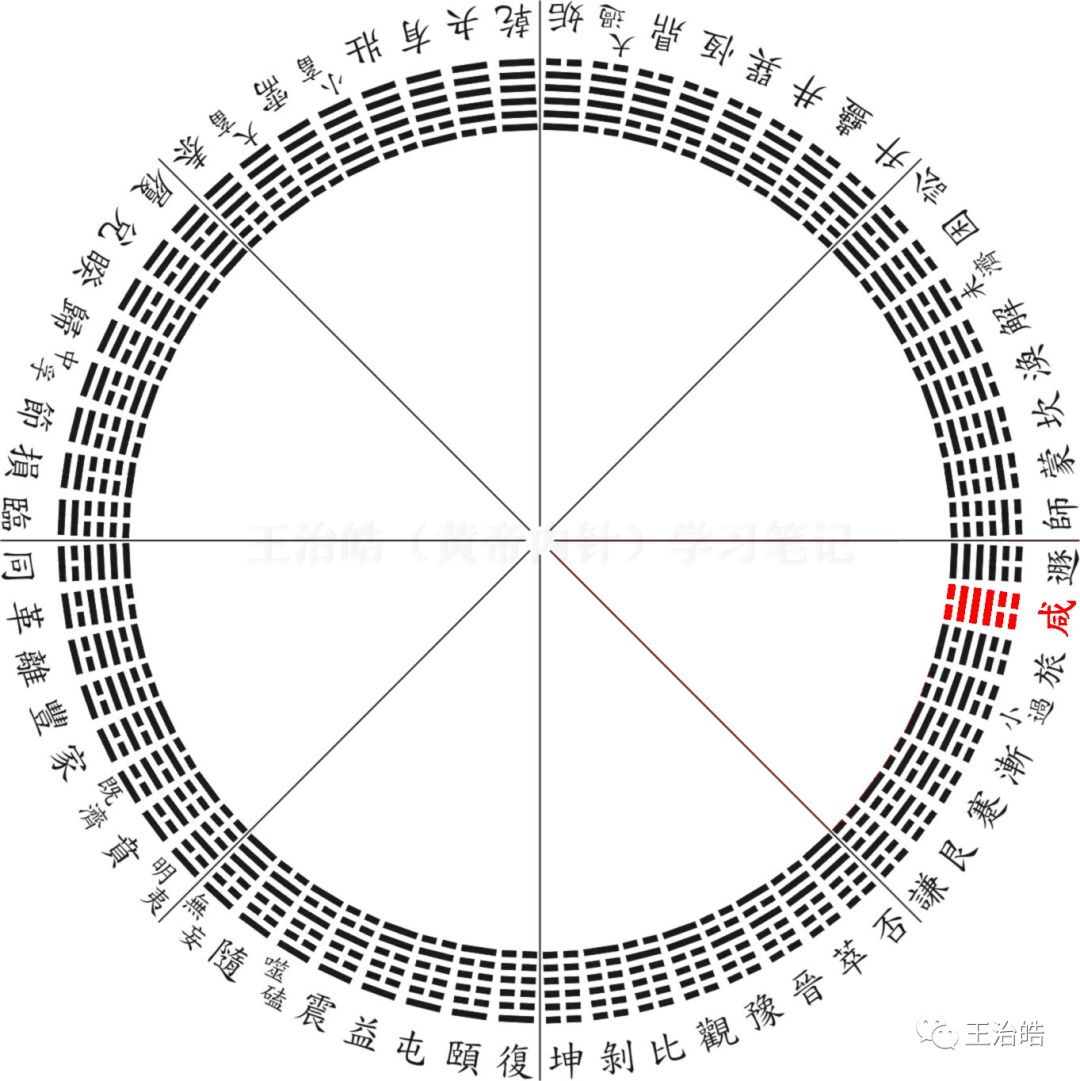
The upper hexagram of Xian is the young girl (Dui), and the lower hexagram is the young boy (Gen). When the young girl meets the young boy, it is called Xian, or sensation, which is quite subtle. Everyone may recall that when we first experienced love, when the young girl met the young boy (or vice versa), our faces would flush. What is that feeling? That is called “sensation”! There is nothing messy about it; it is simply a unique and sweet feeling. I see that some people are already recalling that moment, immersed in the joy of it, truly a meeting of hearts.
In the I Ching system, there are many hexagrams where females meet males, but only this hexagram is called Xian, which is worth exploring. The attraction between the opposite sexes of Yin and Yang is a natural phenomenon, and this attraction in the Xian hexagram is described by Confucius as: “The two energies respond to each other, stopping and rejoicing.” Clearly, this attraction is beautiful, pure, powerful, and transcends mere romantic matters! From Xian, we derive the concept of Xian Chi, which later evolved into the concept of Tao Hua (Peach Blossom), thus becoming entangled in the desires between men and women, leading to infinite suffering. Therefore, “stopping and rejoicing” is indeed thought-provoking.
The feelings of heaven and earth, the states of all things, the good and the bad, all arise from this “two energies responding to each other.” The two energies, whether heaven and earth, or male and female, or hard and soft, represent Yin and Yang. And how do Yin and Yang respond to each other? I believe it is as stated in the “Suwen”: “Drawing Yang from Yin and Yin from Yang.” As mentioned earlier, these eight characters are the guiding principles of Dao Yin, and sensation is the key to Dao Yin. Sensation, as defined in the “Kangxi Dictionary,” means “to touch”; when Yin and Yang (the two energies) touch, there is awareness, knowledge, and response, hence the terms sensation, perception, and response. Because of sensation, there is awareness; also because of response, there is a connection and power. Thus, sensation is a process that involves both awareness and power.
By touching and pressing the Ren meridian and Yin Qiao in the Yin regions, we will first trigger awareness of the movement and stillness in the Yang regions, which is the process of sensation and also the process of Dao Yin. This movement, this awareness, this power will become clearer as the sensation deepens and the Dao Yin deepens.
I (Teacher Liu Lihong) would like to emphasize again that Dao Yin is a skill; as a skill, it requires time and cannot be achieved overnight. I cannot guarantee that everyone will immediately experience such sensation, because through Xian we can glimpse why the meeting of the young girl and young boy is defined as Xian. What qualities do young boys and girls possess? I believe purity is the most basic quality! Purity is the characteristic of young boys and girls, the basic condition needed for Xian and sensation, and it is also the fundamental requirement for Dao Yin. Purity means being pure, simple, and unadulterated; this is what Dao Yin should strive to achieve. Truth means being genuine and real; Dao Yin must have authentic and personal sensations; without personal sensations, there can be no Dao Yin.
Now we can try to experience this “sensation.” Please gently close your eyes. Usually, I (Teacher Liu Lihong) lie down relaxed on the bed to do this, but now everyone can sit comfortably. We can bring our fingers (mainly the index, middle, and ring fingers) together and gently press them on the front center line (Ren Qiao meridian); this process is drawing from Yin, and whether the drawing of Yang can occur largely depends on our sensation! Of course, this “sensation” may not appear immediately or may not be very clear at first, but it will gradually emerge and become clearer.
(See video below ↓)
I Statement Information:
This article is selected from: the internet.The articles shared by this public account are for reference and learning purposes only. If there are any improper uses of the published content, please feel free to contact us. Please retain copyright information when reprinting.All formulas and treatments mentioned in the text are for learning reference only; non-professionals should not attempt to use them!

